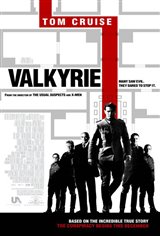Athough German and a member of the military, Claus von Stauffenberg never joined the Nazi party. Even though he agreed with some of its nationalistic aspects, he found most aspects of the party's ideology repugnant. Born in 1907, he joined the military in 1926, alongside his two older brothers. When the war broke out in 1939, he took part in the attack on Poland. But Hitler's despicable treatment of ethnic and religious minorities, as well as the Nazi party's suppression of religion, including his own Catholicism, led him to accept his Uncle Nikolaus Graf von Uxkill's invitation to join the German resistance movement against dictator Adolf Hitler.
Mass executions of Russians, Ukrainians, Jews and other minorities enforced Stauffenberg's resolve to bring down the Nazi party. He continued on as a German officer, accepting a placement in Africa in 1943, but while there his vehicle was attacked by British aircraft and he lost his left eye, his right hand, and the fourth and fifth fingers of his left hand. He was brought home to recuperate, and awarded the Wound Badge and the German Cross for his courage.
His resolve to take down the Nazis didn't lessen, however, and he managed to convince a conspirator to get him placed as a staff officer in a training headquarters in Berlin. General Friedrich Olbricht, one of his superiors, was in charge of the headquarters and was also a committed member of the resistance movement. Called the Ersatzheer, the training headquarters was in a good position to0 stage a coup, as one of its functions was Operation Valkyrie.
Valkyrie was an operational plan approved by Hitler himself. It was to be implemented if a disruption caused by the Allied bombing of German cities resulted in a breakdown in law and order, or in case of a rebellion by the millions of laborers from occupied countries who were forced to work in German factories.
Ironically, the German Resistance modified Valkyrie to use it to plan the assassination of Hitler, followed by the takeover of German cities, to disarm the Nazi organization SS, which was responsible for many of the worst crimes against humanity perpetrated during WWII, and arrest the Nazi leaders who'd served under Hitler. Stauffenberg was instrumental in the plan. His position allowed him access to Hitler for briefing reports.
When several suicide bombing attempts on Hitler's life failed, on July 20, 1944, he put two small bombs in a briefcase and traveled to meet with the dictactor. Because the meeting place changed, and Stauffenberg had difficulty arming the bombs due to his lack of fingers, he was only able to arm one of the two bombs before the meeting took place. He placed the briefcase under the conference table, as close as possible to Hitler. He then excused himself, saying he needed to make an urgent phone call and waited for the explosion. Four people were killed in the blast, and most of the other people in attendance were wounded.
Stauffenberg and his accomplice, Oberleutnant Haeften, assumed that their mission was a success. They left the compound, disposing of the second bomb in a small forest on their way to a nearby airfield. As they were on their way back to Berlin, Hitler, who'd survived the blast with only minor injuries, issued orders to shoot them on sight. At 7 p.m. that evening, the dictator broadcast a message on the radio to prove that he had survived the assasination attempt, and Stauffenberg and his co-conspirators realized that their efforts were in vain.
It's believed that the bomb was placed behind a thick leg of the heavy oak conference table, deflecting the blast and preventing the full force from reaching Hitler. It's also believed that if Stauffenberg had left the second bomb in the briefcase, that the blast from the first bomb would have detonated the second one, thus giving off enough force to kill Hitler.
Stauffenberg was taken into custody, quickly tried and convicted, and executed by firing squad on July 21, 1944 at the age of 36. He was His last words were "Long live our holy Germany!" Others involved in the plot were tried, including Stauffenberg's eldest brother, Berthold. He was one of eight conspirators executed by slow strangulation. More than two hundred others were also executed.
Stauffenberg left behind a wife and five children, aged 10 and under—one was born after his execution. The three oldest were placed in foster homes for the remainder of the war and forced to change their last name.
In 1980, the German government named a street after Stauffenberg, and established a memorial for the failed anti-Nazi resistance movement. A plaque commemorating the events was erected in the courtyard where Stauffenberg was shot.

